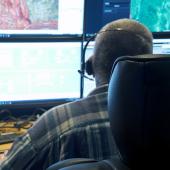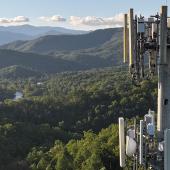This blog is a repost from the New York State Association of Chiefs of Police Chief’s Chronicle, originally published in December 2019. The original article can be accessed here.
The last decade has brought about rapid advances in technology that have changed our daily lives. The first smartphones hit the streets in 2007, and today nearly every American has at least one in their pocket.
Police chiefs nationwide have also steadily increased their departments’ use of mobile broadband technology over the last ten years to help capture and share information and coordinate responses during both routine and emergency situations. But with the rise of consumer’s use of data via smartphones, commercial networks have become heavily congested and law enforcement often has to compete for a connection. This might be why your phone has four bars and you still cannot make a call, your local cell site might be at capacity.
This is one reason why public safety officials called for their own dedicated nationwide public safety broadband network. In 2012, Congress heard the call and passed legislation creating the First Responder Network Authority (FirstNet Authority) and charged the agency with ensuring the delivery of the nationwide public safety broadband network, known as FirstNet. At the heart of the FirstNet effort is the need for a reliable communications platform for public safety to make use of mobile devices and apps that support them in the field. With a reliable broadband network, law enforcement officers can take advantage of new technologies to help protect communities and keep themselves safe even when commercial cellular networks become congested.
As technology use increases, large and small law enforcement agencies across New York require the mission critical broadband network to easily support interoperable communications and to stay connected across distances, jurisdictions, and public safety disciplines. This is particularly important in New York, where police agencies face a unique operational landscape. Many times officers need to communicate with agencies across five other neighboring States. In the future, international cross-border communications might also be aided by public safety broadband as Canada is working to deploy its own network for first responders with the same broadband frequencies used in the United States.
FirstNet designed for public safety use
Today, FirstNet is available nationwide with more than 9,800 public safety agencies using nearly 900,000 connections. FirstNet is being used to support first responders from law enforcement, fire, EMS, emergency managers, as well as those entities that support emergency response like schools and hospitals. The network has played a vital role in keeping law enforcement connected during critical events and emergencies, including both manmade and natural:
- Severe weather events like flooding where infrastructure maybe damaged,
- School shootings campus lockdowns that instantly reach network capacity,
- New York State Fair in Syracuse which strains law enforcement communications in crowd situations,
- Orange County International Airshow that involves difficult terrain and crowds, and
- Rural search and rescue missions that happen where coverage is sparse.
The FirstNet Authority’s mission is to ensure the building, deployment and operation of the network. In 2017, AT&T won the contract award through a Federal procurement process to build and operate the FirstNet network. Through this public-private partnership, AT&T is providing priority and preemption for first responders, and building out FirstNet’s high quality Band 14 spectrum specifically reserved for public safety. With Band 14 connecting first responders in over 650 U.S. markets and growing, FirstNet is expanding reliable coverage and capacity throughout New York state and nationwide.
Additionally, to further improve the FirstNet experience, AT&T offers priority and preemption to first responders over its existing network to cover all 50 states, 5 U.S. territories and the District of Columbia, including rural communities and tribal lands. This means that today, FirstNet subscribers have prioritized, interoperable communications nationwide – even when they step outside of their jurisdiction. For example, when Troy Police Chief Brian Owens takes his FirstNet device with him to a meeting in the State of Washington, or Washington DC, or any other U.S. state or territory, he will have the same priority as if he was in his office in downtown Troy, NY.
FirstNet’s unique capabilities benefit users in New York
In New York, coverage requirements are top of mind for public safety agencies. Part of AT&T’s contract with the FirstNet Authority is to build out the network in rural areas simultaneously with metro areas. The FirstNet Authority and AT&T are working closely with the New York Division of Homeland Security and Emergency Services Office of Interoperable and Emergency Communications (OIEC). Regular meetings and updates occur to monitor the progress of the FirstNet buildout, which includes adding Band 14 equipment to existing cell sites or building new cell sites where public safety identified a need for improved coverage based on calls for service. New towers do not occur over night though – FirstNet cell sites must go through the same state and local processes for new construction which may include obtaining lease agreements, completing local zoning processes, or compliance with environmental protection regulations. FirstNet is just over one and half years into a 5 year build plan and progress is being made.
In a further step to improve user experience, FirstNet users have access to FirstNet’s dedicated deployable assets at no extra cost to bolster coverage and/or capacity during natural disasters or large planned events. Depending on the need, these assets can be in the form of a satellite connected cell-site on a light truck (SatCOLT), or a cell mounted on a trailer or truck called a cell on wheels (COW), or now, a cell attached to a tethered drone (Flying COW).
As the network grows and expands, FirstNet subscribers can expect a vastly different experience when communicating over the network. FirstNet is delivering the network the public safety asked for to help them with every day operations and in emergencies by providing a dedicated public safety core—physically separate, highly secure infrastructure that helps ensure public safety communications and data are not compromised by riding a core filled with commercial traffic and unsecure connections. And, FirstNet’s mission is to ensure users can communicate seamlessly and securely utilizing a collection of applications that are identified in the FirstNet App Catalog. These public safety apps will be either “listed” or “certified” depending on the level of security review the app developer goes through. If you have a favorite law enforcement application, we want to know about it.
Additionally, FirstNet subscribers also have access to a growing marketplace of public safety devices to support their mission such as a ruggedized smartphone that can mimic a portable radio, or in-the-pocket push-to-talk accessories to enable undercover units. And over all of this, the FirstNet Authority is providing contract oversight and validation to ensure AT&T is delivering the network public safety as asked for.
FirstNet in action
During emergencies, often New York’s law enforcement officials must communicate with public safety in other parts of the state. FirstNet serves as a dedicated “fast lane” for subscribers to stay connected to their colleagues, even during times of heavy congestion. With FirstNet, subscribers can share data-rich information, such as text, images or video, over a secure, reliable network. The more information officials have, the better their situational awareness.
FirstNet makes it possible for law enforcement agencies to reliably connect and take advantage of new technologies designed to help augment their day-to-day operations – including mobile access to records and databases; mapping tools for tracking the location of vehicles and personnel; connecting dash-cams or body-cams to the cloud for data management or connecting into video cameras and communications networks for school safety.
For Troy Police Chief Owens, a recent FirstNet demonstration illustrated the network’s ability to offer a differentiated emergency communications experience in the city’s densely populated urban setting. Serving 9.5 square miles, the Troy Police Department is a full service, NYS accredited law enforcement agency with 131 sworn officers. The agency is responsible for the safety and security of 50,000 full-time residents and another 20,000 students that attend the city’s three local colleges. Part of the tri-city area, it is also critically important for Troy’s police department to stay in close communication with neighboring Saratoga and Albany counties to share information or respond to cross jurisdictional crimes.
During the FirstNet demonstration, Troy’s police department operated FirstNet-issued devices for officers to test the network’s data and voice capabilities at different times of the day. Instead of competing with the public on commercial wireless networks, the officers experienced FirstNet’s priority and preemption service without signal delay or disruption.
“Congestion on wireless networks has a negative impact on our operation,” said Chief Owens. “With a system like FirstNet that builds in priority and preemption, this allows us to communicate without being disrupted if the system is overloaded by other users.”
After his team experienced FirstNet firsthand, the demonstration convinced Chief Owens to contact FirstNet-AT&T to subscribe to the network. Soon, the City of Troy Police Department will join other law enforcement subscribers nationwide that are connected to FirstNet to enhance communication during times of crisis and in support of community events.
Engage with the First Responder Network Authority
As FirstNet continues to help law enforcement agencies across the nation, we want to hear from you on how the network can make the biggest impact in your community. The input we receive from law enforcement will be used to improve and enhance the network. Public safety fought for this network, and FirstNet has been built to meet your coverage and capacity needs and to modernize emergency communications.
David Cook is a Senior Public Safety Advisor for the First Responder Network Authority. You can reach him at David.Cook@firstnet.gov. Learn more about the FirstNet Authority’s engagement opportunities at FirstNet.gov and find information on FirstNet products and solutions at FirstNet.com.




















